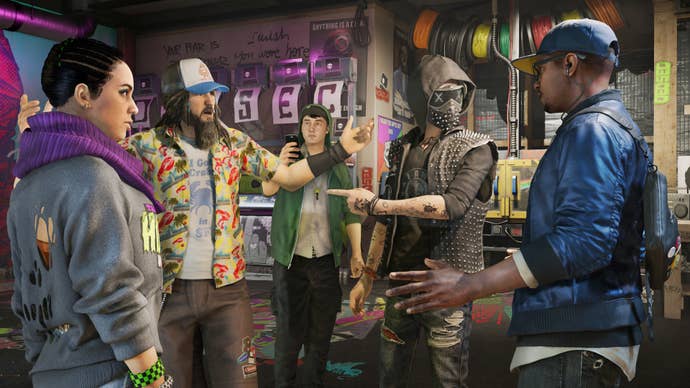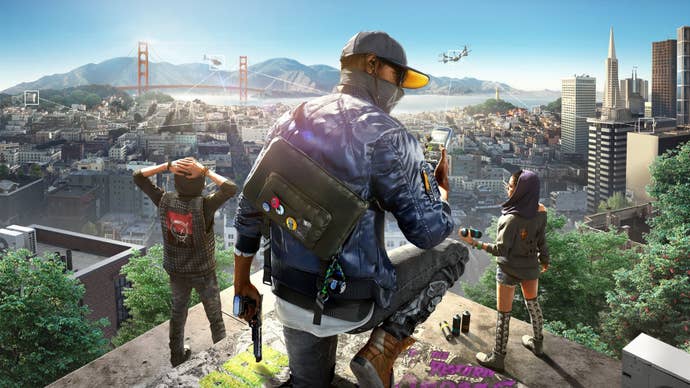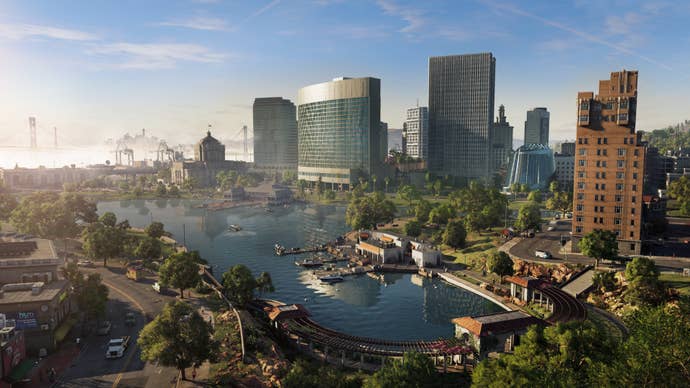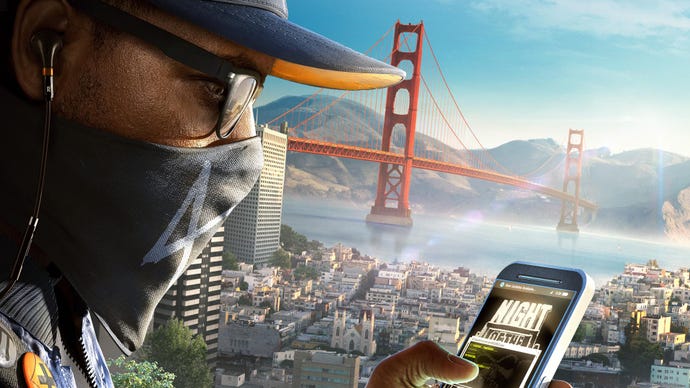Ubisoft's best open world isn't in Assassin's Creed or Far Cry, but in Watch Dogs 2
After a bland, uninspired first game, Ubisoft rallied to make one of its most interesting settings in Watch Dogs 2's hacktivist fantasy.
The original Watch Dogs was an all-time stinker. Released back in 2014, it represented the absolute nadir of Ubisoft open-world design. It was a dour, joyless slog that had no idea how to actually engage with any of the themes or ideas raised by its near future Big Tech Dystopia setting. The protagonist – Aiden Dogs – instantly became the poster boy for bland, uninspired leading men in videogames.
The whole thing reeked of a design by committee obligation created solely to hype the potential of the upcoming PS4 and Xbox One, one of those swanky trailers for a launch title that’s destined to be quietly cancelled and forgotten about – but this one, inexplicably, made it to release somehow. That really should have been the end of Watch Dogs, and for many of you it probably was.
It’s hard to imagine a game that had fewer expectations than Watch Dogs 2. It seemed like a mistake at first, something Ubisoft had pencilled into their schedule under the assumption that the first game was going to be a smash hit. Lack of corporate oversight coupled with absolutely zero anticipation probably goes some way to explaining how it ended up being one of the greatest open-world videogames ever made.
The gun-toting murder machine Aiden Dogs is nowhere to be found, instead you now play as the much younger, much less tortured Marcus Holloway. Aiden opens Watch Dogs 1 by shooting a hitman in revenge for murdering his 6-year-old niece. Marcus begins his quest against the inhuman oligarchs of Silicon Valley by having to buy some new trousers after sneaking out of a one-night stand’s bedroom. The tonal shift is delightful enough, but what’s even more welcome is that the opening mission shows a better understanding of the insidious relationship between the tech industry and law enforcement than the original game managed in its entire duration.

Marcus sneaks into the headquarters of Blume, the company that builds and maintains CTOS – a city-wide big data management system ostensibly designed to assist infrastructure, but mostly used as an omniscient surveillance platform for the state. He’s there to erase his profile, an amalgamation of the data generated from his life. He opens it up and sees that the system considers him a dangerous individual. The system has flagged such Undesirable Activities as attending left-wing political conferences and loitering.
Wiping his record clean still leaves his threat assessment still suspiciously high, owing to his black skin. Such an early acknowledging of the racism baked into much of the data industry was a real relief after how embarrassingly flimsy the first game’s grasp was on its own source material. Afterwards, Marcus and his crew of fellow young hacktivists celebrate on the beach and discuss how CTOS and its symbioticism with other industries is poised to kill their futures.

Even more impressive is the city itself. Aiden’s Chicago was as boring and damp as he was, Marcus’ San Francisco is an absolute joy. The sun is constantly beaming down from a cloudless sky, highlighting all the colourful details of the streets below. The sidewalks heave with pedestrians and they’re far from the mannequins on invisible conveyor belts you’d expect from a game this size. You have access to a minimal range of emotes, but the scale at which they can interact with the various systems governing the NPCs can generate some of the most organic and chaotic fun you’ll have in an open-world city.
Photobomb a couple’s beach selfie by dancing in the background and the woman might laugh while the man starts hurling abuse at you and shoving you. Try to calm down an altercation between two pedestrians and you just might start an all out street brawl as harsh words turn into harsher fists and stray punches turn more innocent passer-bys into willing participants. I once wandered into Not Google HQ to try out the fun slide in their lobby. I jokingly flipped the bird at the people waiting at the bottom of the chute as I came out. An employee absolutely flipped her lid, calling me a huge piece of s**t and pushing me. A nearby security guard came over to try to pacify her and she turned her aggression towards him, receiving the business end of a taser in return.

The game itself lends itself far more toward pacifist and non-direct approaches than the first game. There’s the usual selection of non-lethal firearms, sure, but where’s the fun in that? Far more interesting is the remote control car and eventual helicopter Marcus can get to act as his proxy. Each micro-mission area populating the open world is a secret RC car obstacle course, filled with vents and ramps and perfectly measured jumps that can let you navigate your little friend to your objective.

Coupled with more robust powers to tag and distract enemies through surveillance cameras, it’s entirely possible to clear most of these without ever actually having Marcus set foot in a restricted area, making it all happen while he’s sat comfortably on his laptop outside a cafe down the street. Like an actual hacker! In a game series supposedly about hacking!
For all its strengths, Watch Dogs 2 doesn’t quite manage to fully escape the perils of Ubisoft development unscathed. The main storyline has a couple of tonally misjudged beats that feel like they belong in a different game entirely. You could have spent 20 hours dancing with frat boys and doing silly little stunts with your RC car - it won’t stop the next cutscene from having Marcus find the brutally murdered body of one of his friends and picking up a gun to swear bloody revenge on the underground dogfighting gang responsible.
It’s like a Far Cry producer snuck in during the dead of night to add it without anybody noticing. Similarly tone-deaf features include an upgrade path dedicated to letting players send armed police to NPCs, something that Marcus as he’s presented in the narrative would absolutely take issue with.

Despite a couple of false steps narratively and mechanically, Watch Dogs 2 (recently added to Xbox Game Pass) is a vital and interesting experiment in making an open-world that you can interact with beyond shooting at enemies behind cover.
It’s understandable if you had completely written this series off after the first entry, but if you have any interest in gorgeous virtual cities and emergent gameplay you absolutely owe it to yourself to give the second entry a chance.
